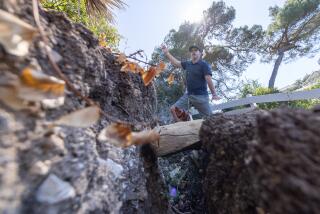A Real Cliffhanger
- Share via
For those downtown-bound drivers invariably slowed on the connecting road between the Golden State and Pasadena freeways--staring up at a cliff-side construction site of wires, rods and metal circles--here is what the project causing your vexing ride is not:
* Installation of hundreds of seismic sensors.
* A soil survey.
* A secret NASA operation.
* A set for an aliens-invade-earth movie.
* An actual alien invasion.
The real reason you’ve been slowed to a virtual stop is much more mundane, an explanation hinted at by two small signs at the beginning of the connector road from hell that reads, “ROCKSLIDE AREA.”
Since November, Caltrans has been working to keep the rocks and debris that make up this precipitous, Elysian Park slope from crashing down onto cars below. Because of a cliff face with angles as steep as 75 to 80 degrees at some points, the more conventional methods of stabilization are not enough to keep the pieces of hillside where they belong.
“Being in construction, you see all kinds of activity--bridge work, high-rise construction--so we take this in stride,” said George Chirinian, Caltrans’ senior transportation engineer for the region. “But if you’re driving by and you see these guys hanging from ropes and all that, it does look unusual.”
In what Caltrans engineers say is the first such effort in Los Angeles and Ventura counties, workers are using a method known as slope netting to anchor two layers of thick steel mesh onto the hillside.
Anyone who thinks that sounds simple has not seen the cliff in question.
To complete the project, the Caltrans contractor who was awarded the $1.2-million contract uses specially trained workers who can rappel down the cliff on ropes while performing construction tasks.
Cranes at the top of the hill pick up the 750-pound rolls of steel netting and ferry them to workers, who perch at various points on the rock face to unroll the netting and secure it. When the work moves below the crane’s 50-foot reach, the workers rely on helicopters to grab the 13-foot-by-150-foot rolls and hover in front of the cliff.
And almost all the drama takes place while the cars crawl by below, whether their occupants are aware or oblivious, all stymied by a narrowed connector road.
Caltrans was first alerted to a problem with the cliff when small rocks began falling onto the roadway about two years ago, Chirinian said. After investigation, the agency decided the city Parks and Recreation-owned cliff side needed stabilization before bigger rocks and debris began coming loose.
Before then it’s unlikely the two-lane connector road in the cliff’s shadow would have given most commuters a second thought.
The small strip of roadway most likely came into being along with the Golden State Freeway, in the late 1950s, one Caltrans historian estimated. Before that, the land now occupied by the nearest stretch of Interstate 5 was just an Arroyo Seco Parkway offramp to Riverside Drive and the connector road was just the grass, dirt and foothills below the cliff.
After the first few rocks started coming down, however, the roadway gave Caltrans something to think about.
The first step in the project was rock scaling, in which workers harnessed to rappelling ropes used crowbars and often their hands to break loose the most unstable rocks, identified by the project geologists. The connector road was completely closed down for that stage because workers simply let the loosened debris fall to the ground.
Next the rappelling construction workers embedded long steel rods, called anchors, every three meters horizontally and vertically along the hillside. After each anchor’s hole was filled in, usually with concrete, a one-foot diameter metal plate was placed on top of the anchor like a giant bolt. (Thus the discs and rods dotting the hillside that gave rise to some commuters’ sensor theories.)
The workers are now in the netting stage, unrolling 150-foot-long rolls of wire mesh that look like flexible chain-link fences. Coated with plastic that matches the dirt on which it will sit, the netting is double-layered, fastened at the top of the hill and then slowly stretched down to the waiting workers.
From there, the workers run half-inch-thick steel cables over the mesh from anchor to anchor, creating a crisscross on top of the mesh, and then secure the cables to the netting.
Weather permitting, the entire process should be completed within four weeks, Chirinian said.
In the meantime, with only one lane to support both drivers who must use the road and the looky-loos gawking at the site above, the traffic situation is unlikely to improve.
“Whenever we do construction, people don’t have any idea what we’re doing,” said crane operator Dwayne Knoll, who from his perch atop the hill can’t see the traffic headache on the connector road below. “They just think we’re doing anything and everything to hinder their ability to get from here to there.”
More to Read
Sign up for Essential California
The most important California stories and recommendations in your inbox every morning.
You may occasionally receive promotional content from the Los Angeles Times.










